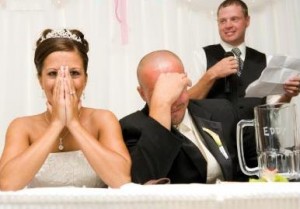Wedding celebrations aren’t just about feting the bride and groom; they’re also about honoring the friends and family who have supported and loved the couple throughout their relationship and in their individual lives. Bridesmaids and groomsmen deserve to be lauded for their support of the betrothed duo. They’ve likely been there from the beginning, as sisters and brothers, close cousins, childhood best friends, college roommates, and caring co-workers. The wedding party tradition is common throughout the United States and the world, whether the bride and groom choose to have ten maids and men apiece or just one best woman and man. But when and where did this custom begin?
The institution of incorporating bridesmaids and groomsmen into a wedding ceremony dates all the way back to ancient Rome. These highly-honored wedding guests wore matching attire, with the bridesmaids fashioning their hair into soft curls that hung down their backs accompanied by a simple headband. These styles are frequently seen in ancient Roman works of art.
Ancient Romans were quite superstitious. Ten maids and ten men stood by the bride and groom to protect them from evil spirits. Bridesmaids and groomsmen dressed identically to the bride and groom, respectively, to confuse these malicious forces. The thinking went that, if all of the women and all of the men were dressed the same, then the vile demons would not be able to target the bride and groom specifically. Today’s weddings are still laden with superstitions, whether we recognize them or not. The saying, “something old, something new, something borrowed, something blue” brings this to mind. And perhaps we’re still concerned about keeping bad vibes away on our wedding days, explaining why today’s brides and grooms continue to have several close confidants by their sides when they say, “I do.”
Protecting the duo–and mainly the bride–was the primary mission of bridesmaids and groomsmen in ancient Rome. In fact, groomsmen would accompany the bride (not the groom) to the celebration in order to protect the woman from thieves who might steal her dowry. And why ten bridesmaids and ten groomsmen? Because ancient Roman law required that ten witnesses be present for every wedding.
As time marched on, concerns about evil spirits and safeguarding the dowry abated. Eventually bridesmaids were not required to dress in the exact same fashion as the bride. This was probably a relief during the Victorian era when wedding gowns featured bustles, full-court trains, and long veils. Luckily the bridesmaids were only expected to wear somewhat simpler white dresses with short veils. Today, brides and bridesmaids might feel better knowing that they are not beholden to these traditions, since we see bridesmaids’ dresses in a variety of colors and styles. And none of these bridesmaids’ dresses are facsimiles of the bride’s gown.
The responsibilities of groomsmen are much less serious now. No longer are they literally protecting the life and wealth of the bride. Now, groomsmen are enlisted to plan the bachelor party, usher wedding guests to their seats at the ceremony, and to escort bridesmaids down the aisle.
In the modern tradition, bridesmaids and groomsmen are ultimately there for support and companionship. And the most prominent way that they do so is by giving a toast to honor the bride and groom. At many weddings only the maid of honor and the best man stand up before the entire reception, raising a glass of champagne and giving a speech. But depending on the bride and groom’s wishes, other maids and men might also give a speech. So, where did this tradition originate?
Hundreds of years ago in Nurnberg, Germany a young goldsmith fell in love with a noblewoman. The young woman’s father did not approve of this relationship, throwing the goldsmith in prison in an effort to squash the romance. But this tactic didn’t work and the noblewoman became increasingly depressed. Her father made a deal with the goldsmith: if he could create a chalice out of which two people could drink without spilling a drop, then the goldsmith was allowed to marry his daughter. The young man succeeded, designing a cup in the shape of a woman holding a swinging bucket out of which two people could drink. The young woman’s father was impressed and gave his blessing for the marriage. At the wedding celebration, the bride and groom toasted their nuptials with the Bridal Cup, a shared experience that bonded them together in love. Today, when newlyweds are toasted by the maid of honor, the best man, bridesmaids, and groomsmen they are symbolically sharing the Bridal Cup and, thus, their love.
Bridesmaids and groomsmen have therefore been standing in support of their loved ones for centuries. While their responsibilities and fashions have changed over time, they have always been an important part of a wedding ceremony, acting as protectors of the bond between the bride and groom.


Comments are closed.